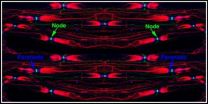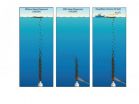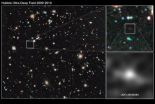(Press-News.org) CHICAGO (January 26) – Scientists at The Rehabilitation Institute of Chicago (RIC), designated the "#1 Rehabilitation Hospital in America" by U.S. News & World Report since 1991, report that, thanks to improvements in technology and data analysis, our understanding of the functional principles that guide the development and operation of the brain could improve drastically in the next few years. The advances could herald a neuroscientific revolution, much as increasing processor speeds paved the way for the computing revolution of the last half century.
In the February, 2011 issue of Nature Neuroscience, the researchers, Dr. Ian H. Stevenson and Dr. Konrad P. Kording, performed a meta-analysis of 56 studies conducted since the 1950s (the advent of multi-electrode recordings) in which the activity of neurons was recorded in animals or humans. They found that the number of simultaneously recorded single neurons has grown exponentially since the 1950s, doubling approximately every seven years.
The researchers likened the progress in neuronal recording techniques to Moore's law, which describes the exponential growth of processing speed that has doubled approximately every two years, making computers smaller and technology accessible to more people.
"As it becomes easier for us to access and interpret information coming from the brain, we will be able to better help those with disabilities and conditions of the nervous system," said Dr. Kording. "Our goal is to take what we are learning about how and why the brain works so we can quickly and successfully use it to help patients. By decoding how neurons communicate with each other, we may one day be able to restore connections by conditioning different neurons to talk to each other, or to talk to each other in different ways, thereby restoring ability in our patients."
The "firing" or "spiking" of a neuron is really a signal sent along a gradient to other neurons and throughout the entire nervous system. These signals send messages and convey important information, including representations about the world and messages that control our behaviors and actions.
According to Dr. Kording, "Recording of only a single neuron at a time was possible in the late 1950s. Now, researchers can record activity from hundreds of neurons simultaneously, gathering valuable information about when and why neurons fire or do not fire."
In patients with conditions caused by lost connections in the brain, such as stroke or spinal cord injury, information from the brain sent via neurons cannot get relayed to certain limbs or parts of the body. Researchers at RIC are using data from neurons to pioneer research designed to restore connections and ability using novel technologies. In fact, RIC researchers recently reported that they have identified novel ways of potentially re-routing the flow of information in the nervous system using stimulation technology. Currently, RIC researchers are on the cutting-edge of exploring the use of novel brain-machine interface, functional electronic stimulation and virtual reality technology to restore function in individuals suffering from paralysis caused by spinal cord injuries or stroke.
INFORMATION:
About The Rehabilitation Institute of Chicago
The Rehabilitation Institute of Chicago (RIC) is the nation's #1 ranked provider of comprehensive physical medicine and rehabilitation care to patients from around the world and is the leader in research and development of the most cutting-edge treatments and technology in its field. Through aggressive medical protocols, RIC guides the patient care process toward a better patient outcome – involving repair, regeneration and recovery of brain, spinal cord and musculoskeletal function.
RIC holds an unparalleled market distinction with a record six federal research designations awarded and funded by the National Institutes of Health and the Department of Educations' National Institute of Disability and Rehabilitation Research in the areas of spinal cord injury, traumatic brain injury, stroke, neurological rehabilitation, outcomes research and rehabilitation engineering research.
RIC, founded in 1954, has been designated the "#1 Rehabilitation Hospital in America" by U.S. News & World Report every year since 1991 and attributes its leading standard of care in part to its innovative research and discovery, particularly in the areas of bionic medicine, robotics, neural regeneration, pain care and better outcomes. RIC operates its 165-bed, flagship hospital in downtown Chicago, as well as a network of 30 sites of care located throughout the city and surrounding suburbs that provide additional inpatient care, day rehabilitation and outpatient services. RIC also maintains strategic alliances with leading healthcare providers throughout the state of Illinois and Indiana.
RIC study suggests researchers are entering a new era of advances in brain research
As recording technology rapidly improves, neurons give up their secrets cell by cell
2011-01-27
ELSE PRESS RELEASES FROM THIS DATE:
Stimulating the brain's immune response may provide treatment for Alzheimer's disease
2011-01-27
A new target for the prevention of adverse immune responses identified as factors in the development of Alzheimer's disease (AD) has been discovered by researchers at the University of South Florida's Department of Psychiatry and the Center of Excellence for Aging and Brain Repair.
Their findings are published online in the Journal of Neuroscience (http://www.jneurosci.org/).
The CD45 molecule is a receptor on the surface of the brain's microglia cells, cells that support the brain's neurons and also participate in brain immune responses.
Previous studies by the ...
Membrane molecule keeps nerve impulses hopping
2011-01-27
CHAPEL HILL, N.C. -- New research from the University of North Carolina at Chapel Hill School of Medicine describes a key molecular mechanism in nerve fibers that ensures the rapid conductance of nervous system impulses. The findings appear online Jan. 27, 2011 in the journal Neuron.
Our hard-wired nerve fibers or axons rely on an insulating membrane sheath, the myelin, made up of fatty white matter to accelerate the rate of transmission of electrical impulses from the brain to other parts of the body.
Myelin thus acts to prevent electrical current from leaking or prematurely ...
Discovery of a biochemical basis for broccoli's cancer-fighting ability
2011-01-27
Scientists are reporting discovery of a potential biochemical basis for the apparent cancer-fighting ability of broccoli and its veggie cousins. They found for the first time that certain substances in the vegetables appear to target and block a defective gene associated with cancer. Their report, which could lead to new strategies for preventing and treating cancer, appears in ACS' Journal of Medicinal Chemistry.
Fung-Lung Chung and colleagues showed in previous experiments that substances called isothiocyanates (or ITCs) — found in broccoli, cauliflower, watercress, ...
First report on fate of underwater dispersants in Deepwater Horizon oil spill
2011-01-27
Scientists are reporting that key chemical components of the 770,000 gallons of oil dispersants applied below the ocean surface in the Deepwater Horizon spill did mix with oil and gas spewing out of the damaged wellhead and remained in the deep ocean for two months or more without degrading. However, it was not possible to determine if the first deep ocean use of oil dispersants worked as planned in breaking up and dissipating the oil. Their study, the first peer-reviewed research published on the fate of oil dispersants added to underwater ocean environments, appears in ...
Getting more anti-cancer medicine into the blood
2011-01-27
Scientists are reporting successful application of the technology used in home devices to clean jewelry, dentures, and other items to make anticancer drugs like tamoxifen and paclitaxel dissolve more easily in body fluids, so they can better fight the disease. The process, described in ACS' journal, Langmuir, can make other poorly soluble materials more soluble, and has potential for improving the performance of dyes, paints, rust-proofing agents and other products.
In the report, Yuri M. Lvov and colleagues point out that many drugs, including some of the most powerful ...
Fish smile but some consumers frown at new genre of phosphate-free detergents
2011-01-27
Phosphate-free automatic dishwashing detergents — introduced to combat the phosphate-fed algae blooms that foul the nation's lakes and rivers — may be making the fish happy. But they're putting a frown on the faces of some consumers who say the new products leave dishes dirty. That's the topic of the cover story in the current edition of Chemical & Engineering News (C&EN), ACS' weekly newsmagazine.
C&EN Assistant Managing Editor Michael McCoy described how new laws in 16 states require manufacturers to eliminate phosphates from automatic dishwasher detergents sold in ...
Hubble finds a new contender for galaxy distance record
2011-01-27
Astronomers have pushed the NASA/ESA Hubble Space Telescope to its limits by finding what is plausibly the most distant and ancient object in the Universe [1] ever seen. Its light has travelled for 13.2 billion years to reach Hubble [2], which corresponds to a redshift around 10. The age of the Universe is 13.7 billion years.
The dim object, called UDFj-39546284, is likely to be a compact galaxy of blue stars that existed 480 million years after the Big Bang, only four percent of the Universe's current age. It is tiny. Over one hundred such mini-galaxies would be needed ...
Shockable cardiac arrests are more common in public than home
2011-01-27
Cardiac arrests that can be treated by electric stimulation, also known as shockable arrests, were found at a higher frequency in public settings than in the home, according to a National Institutes of Health-funded study appearing in the Jan. 27 issue of the New England Journal of Medicine.
The study compared home and public cardiac arrests under various scenarios. For example, the study considered whether bystanders or emergency medical services (EMS) personnel witnessed the cardiac arrest, and whether the person experiencing the arrest received treatment with an automatic ...
Hubble sees farther back in time than ever before
2011-01-27
Pasadena, CA— Astronomers have pushed NASA's Hubble Space Telescope to it limits by finding what they believe to be the most distant object ever seen in the universe—at a distance of 13.2 billion light years, some 3% of the age of universe. This places the object roughly 150 million light years more distant than the previous record holder. The observations provide the best insights yet into the birth of the first stars and galaxies and the evolution of the universe. The research is published in the 27th January edition of Nature.
The dim object is a compact galaxy made ...
NASA's Aqua Satellite sees Tropical Depression Anthony heading toward Australia
2011-01-27
NASA's Aqua Satellite captured a visible image of the former Tropical Storm Anthony, now weakened to a tropical depression, but forecasters aren't counting Anthony out yet. Despite its weakened condition Anthony continues to move west toward Queensland, Australia and into a more favorable area for sustaining a tropical cyclone.
The Atmospheric Infrared Sounder (AIRS) instrument that flies aboard NASA's Aqua satellite captured a visible image on Jan. 26 at 03:23 UTC of Tropical Depression Anthony in the South Pacific Ocean. The image revealed a cloud-filled center of the ...
LAST 30 PRESS RELEASES:
Global psychiatry mourns Professor Dan Stein, visionary who transformed mental health science across Africa and beyond
KIST develops eco-friendly palladium recovery technology to safeguard resource security
Statins significantly reduce mortality risk for adults with diabetes, regardless of cardiovascular risk
Brain immune cells may drive more damage in females than males with Alzheimer’s
Evidence-based recommendations empower clinicians to manage epilepsy in pregnancy
Fungus turns bark beetles’ defenses against them
There are new antivirals being tested for herpesviruses. Scientists now know how they work
CDI scientist, colleagues author review of global burden of fungus Candida auris
How does stroke influence speech comprehension?
B cells transiently unlock their plasticity, risking lymphoma development
Advanced AI dodel predicts spoken language outcomes in deaf children after cochlear implants
Multimodal imaging-based cerebral blood flow prediction model development in simulated microgravity
Accelerated streaming subgraph matching framework is faster, more robust, and scalable
Gestational diabetes rose every year in the US since 2016
OHSU researchers find breast cancer drug boosts leukemia treatment
Fear and medical misinformation regarding risk of progression or recurrence among patients with breast cancer
Glucagonlike peptide-1 receptor agonists and asthma risk in adolescents with obesity
Reviving dormant immunity: Millimeter waves reprogram the immunosuppressive microenvironment to potentiate immunotherapy without obvious side effects
Safety decision-making for autonomous vehicles integrating passenger physiological states by fNIRS
Fires could emit more air pollution than previously estimated
A new way to map how cells choose their fate
Numbers in our sights affect how we perceive space
SIMJ announces global collaborative book project in commemoration of its 75th anniversary
Air pollution exposure and birth weight
Obstructive sleep apnea risk and mental health conditions among older adults
How talking slows eye movements behind the wheel
The Ceramic Society of Japan’s Oxoate Ceramics Research Association launches new international book project
Heart-brain connection: international study reveals the role of the vagus nerve in keeping the heart young
Researchers identify Rb1 as a predictive biomarker for a new therapeutic strategy in some breast cancers
Survey reveals ethical gaps slowing AI adoption in pediatric surgery
[Press-News.org] RIC study suggests researchers are entering a new era of advances in brain researchAs recording technology rapidly improves, neurons give up their secrets cell by cell




